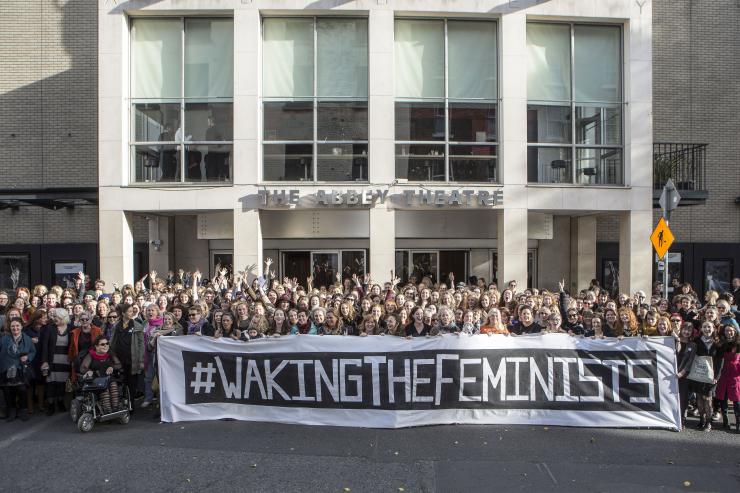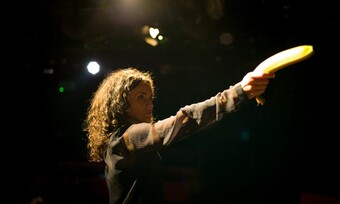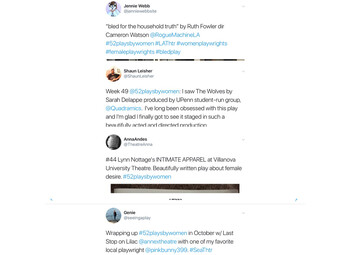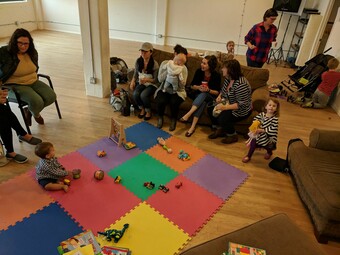Initiatives for Women in Theatre in the UK and Ireland
Two years ago, a man at a writing workshop was waxing lyrical about a recent ballet performance, in which the showcasing of the male dancers had re-enthused him for the form. He usually complained, “the men are just there as props for the women.” The rebuke, from a woman was unsurprising: “Well, now you know what it’s like for us, don’t you?”
The status of women in theatre has been brought into sharp focus over the past two years. The explosive momentum of Ireland’s #WakingtheFeminists campaign is a key example of how the issue has pushed its way to center stage. In 1983, a survey by Sphinx Theatre in the UK of over 1,000 productions revealed that only 11 percent were written by women. Sphinx conducted similar research in 2006 (surveying 104 productions) and found that 9 percent were written by women. In 2014 27 percent of produced plays in the UK were written by women, and that number increased to 32 percent in 2015. Despite this obvious improvement, these figures more clearly show that gender equity simply is not there. Across the top ten subsidized theatres in England in 2011–2012, women made up 33 percent of board members and just 24 percent of directors, and women have taken up just 39 percent of stage roles consistently since 2012.
When we do not see ourselves on stage we are reminded, yet again, that the people running our world do not notice when we’re not there.—Stella Duffy, London-based writer and director

Where Are the Women?
In a 2012 blog reacting to an Equity Campaign to make venues more aware of gender imbalances in programming, London-based writer and director Stella Duffy wrote: “When we do not see ourselves on stage we are reminded, yet again, that the people running our world (count the women in the front benches if you are at all unsure) do not notice when we’re not there.” These words rang in my head as I studied these infographics compiled by #WakingTheFeminists, which show that over the past ten years, only 12.6 percent of writers and 19.6 percent of directors at Ireland’s national theatre, The Abbey, were women. For three of those years (2006, 2008, 2014), not a single female playwright was produced on either of the venue’s stages. It is staggering that someone else had to point out to this state-subsidized theatre that they had a gender equality issue. But to paraphrase Duffy, it seemed no one noticed that we were not there.
I researched the productions from Dublin’s New Theatre, which many call the Abbey for new play development, from 2010–2015 and compared it to the infographics on The Abbey. (The Abbey data runs from 2008, but New Theatre data was available only from 2010). I didn’t include ensemble productions, or those where no director was listed in the results; hence, the numbers given are less than the New Theatre’s full catalogue. Still, this new work venue has had 23.1 percent of its plays written by women, against the Abbey’s 12.6 percent, with women making up 29.4 percent of the New Theatre’s directors and just 19.6 percent of the Abbey’s. Neither venue can claim to be approaching gender parity, but the fact that a new play venue is closer than a national theatre is hardly surprising.
However, a focus on classic plays shouldn’t automatically limit roles for women. Many classic works are adapted for a modern stage, and although 80 percent of this work in Britain’s National Theatre over the last ten years has been done by men, there is no good reason this should remain the case. And a focus on classics, where the weight of history is behind male playwrights, shouldn’t mean that directors are predominantly male. Some kind of bias must exist, an underlying belief that women aren’t capable of as much. If this is a conscious bias, it’s indefensible. Even if the bias is unconscious, its effects are so strong that the theatre community has a responsibility to consciously account for it. Research conducted by the American Lilly Awards Foundation found that there was gender parity in staff who could be considered “next in line” for a leadership role, which disappeared one level up. They suggested this was the result of a culture where we are more used to seeing men as leaders. Female dance professionals in the UK reported that they are advised, in tight funding environments, to keep their work and ambition small as a way to keep practicing. Their perception was that this advice was not given to men.
Work life balance could be a considerable stumbling block to women making the transition from emerging to established artists. The anti-social hours and sporadic work of theatre is not conducive to any kind of caregiving work, and caregiving tends to fall on women. Society as a whole is also more likely to encourage men to take risks, including “risky” careers such as those in the arts.
The tendency to limit women to eye candy and/or props for men, coupled with stories not being written and/or directed by women, comes from a place where women’s stories aren’t put on an equal value to those of men—and ultimately deprives us of the platform we need to start telling more of our own stories.
Shifting Systemic Sexism
The lack of women on our stages has implications wider and deeper than we may realize. The tendency to limit women to eye candy and/or props for men, coupled with stories not being written and/or directed by women, comes from a place where women’s stories aren’t put on an equal value to those of men—and ultimately deprives us of the platform we need to start telling more of our own stories. Duffy says it best:
At a time when young women are being denied education in some parts of the world, when women of all ages are being told they need to cover their hair/their faces/themselves so as not to offend men of various religious sensibilities, when women are being “correctively” raped to shut them (us) up, when abortion rights are being systematically dismantled—why is Equity making a fuss about how many women we see on our (publicly funded) stages? Because it’s all joined up.
Without being able to definitively put a finger on the causes of a problem, it’s difficult to find effective solutions. The UK’s Tonic Theatre’s Advance program was set up both to understand and address the lack of gender equality in theatre. In an interview with Prof. Gilli Bush-Bailey of the Royal Central School of Speech and Drama, Tonic Theatre director Lucy Kerbel said, “We have things that we suspect, things that we believe, but prior to Advance a lot of that wasn’t really proven or investigated.” She feels that much of the response to gender disparity in the arts has been artistic rather than structural—for example, creating festivals exclusively for work by women. “That’s great but why do you need a festival about women?” she asks. “Why aren’t there just more women in your program generally?”
Advance rolled out a pilot program in 2014 in which eleven leading UK theatres were supported to conduct research into not only what barriers to women existed within their own organizations, but also why these barriers were there. The fact that Advance involves a heavy investment by the participating organizations themselves and is based on evidence and information gathering gives it a real potential to bring about a shift in the theatre landscape.
Gathering Support and Artistic Solutions
One example of social media galvanizing and uniting activists is Ireland’s #WakingtheFeminists movement, catalyzed when a greatly anticipated program of ten new plays to commemorate Ireland’s 1916 uprising was announced by Ireland’s national theatre. Only one was written by a woman, only three would be directed by women, triggering an outburst of frustration from scores of Irish female theatre professionals, who were tired of being sidelined and underrepresented in Irish theatre.
Even allowing for the fact that to suddenly find yourself facing massive and unexpected public criticism must be an enormous strain, the initial reaction from the Abbey director was less than apologetic. He tweeted that “Since 2008 we produced three plays by Marina Carr, two plays by Stacey Gregg, and plays by Elaine Murphy, Nancy Harris, Carmel Winters, and Mary Rafferty.” In that time, the Abbey produced seventy-five plays by men.
The #WakingtheFeminists campaign continues to receive enormous support, nationally and internationally—it could be said that the Irish public have never been so aware of theatre in general as they are now, thanks to this campaign.
But artistic solutions also have a part to play, especially as far as underrepresentation of women onstage is concerned. Many of us still base our ideas of good drama on Shakespeare, who wrote for all-male companies in a radically different time, and whose entire catalogue features 826 male characters and 155 female characters, with only 13 percent of roles with significant speaking parts (over 500 lines) female.
Despite a feisty heroine and feminist intentions, the cast of my first play included two female roles and five male ones. Being young and inexperienced, I suspect that I may have written a more male-centric play because that was what I was used to seeing. Sphinx Theatre created the Sphinx Test as a tool to help playwrights develop better roles for women. Something like the Sphinx Test, which looks at whether a woman is centre stage, drives the action, and avoids stereotype, would have reminded me to think more about gender within my work.
Weak characters make weak writing. Writing more and better female roles isn’t just a feminist statement. It will make for better plays.
The Advance Program
Initiatives to achieve gender parity in theatre are necessary and worthy, but are they working? The Advance program certainly seems to be. Just some of the changes the program has brought include:
- In response to their findings that women are more reticent about approaching theatres (most likely because we are less encouraged to be assertive than men), Cast Theatre is working to “be more proactive in making offers to artists, rather than waiting for them to come to us.”
- Sadler’s Wells dissected some of the reasons many female choreographers don’t transition from an emerging or mid-career to an established artist, and have resolved to provide more mid-career opportunities and longer-term supports to mid-career artists.
- Britain’s National Theatre took a close look at its internal working culture and is seeking training for its staff in meeting facilitation so that meetings will not remain so dominated by male voices or people with “perceived male traits,” such as being louder.
In Ireland, The Abbey has formed a committee on gender balance, and #WakingtheFeminists are working with Tonic Theatre to develop an Irish version of the Advance Programme.
Kerbel has noticed some major shifts in the theatre landscape between the first Advance program in 2014 and its second incarnation in 2016:
[When the project was initiated in 2013] there was a bit more timidity about if this was a problem and what theatres should do about it. In those two years there has been a very definite shift in terms of conversations around equality, representation, access, diversity, becoming louder, more complex, more urgent, having a greater level of traction.
Many of these initiatives, although set up to tackle women’s issues, will benefit theatremakers across the board. For example, #WakingtheFeminists is campaigning for “economic parity for all in theatre.” A reform of the National Theatre’s operating procedures will benefit all who work there.
The overwhelming dominance of white men in all aspects of theatre is a sign that the best person doesn’t always get the job; if they did, there would be a lot more diversity in our theatres. In 2010, women made up 68 percent of theatregoers in the UK. Ultimately, if we don’t start seeing more representation of ourselves on stage, why keep going?









Comments
The article is just the start of the conversation—we want to know what you think about this subject, too! HowlRound is a space for knowledge-sharing, and we welcome spirited, thoughtful, and on-topic dialogue. Find our full comments policy here
Coming from a theatre founded by a woman, and run by a woman for 70 years, and being constatntly surrounded by women at all levels of my artistic and administrative life...it is truly sad to see some of these figures.
All I can say is I wanted to chime in here and support these initiatives.
We are in the middle of a cultural planning process in NYC, and for instance most of the people at the meetings are women, so I am hoping in our equity discussions, gender parity comes about...
For me, theatre has always been a woman's world, we've always had more women in the living theatre's casts, probabley because pay was very low and one had to believe in what we were doing to dedicate the time. I've always seen women as more willing to do that, which is also why I think so many women are in arts admin roles, when they could get the same jobs in corporate settings and make more money, but see the value to others, and their own mental health in being involved in the arts. i am constantly in awe and admiration of the women I work with, and its ten years plus of personal experience now, so I know its just not some odd coincidence.
All the major arts service organizations are led by women...who could easily be union heads in other fields, and we are lucky to have them working on our behalf as a field. I hope we treat them right and their fellow artist counterparts so we don't push them away.